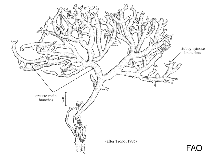Gracilaria salicornia (C. Agardh) E.Y. Dawson
Segmented gracilaria| Native range | All suitable habitat | Point map | Year 2050 |

|
| This map was computer-generated and has not yet been reviewed. |
| Gracilaria salicornia AquaMaps Data sources: GBIF OBIS |
Upload your photos
Google image | No image available for this species;
drawing shows typical species in Gracilariaceae.
Google image | No image available for this species;
drawing shows typical species in Gracilariaceae.
Classification / Names Common names | Synonyms | CoL | ITIS | WoRMS
Florideophyceae | Gracilariales | Gracilariaceae
Environment: milieu / climate zone / depth range / distribution range Ecology
Sessile; depth range 1 - 60 m (Ref. 102161). Tropical
Distribution Countries | FAO areas | Ecosystems | Occurrences | Introductions
Indian Ocean: from the Arabian Sea, including the Red Sea and the Persian Gulf, south to South Africa, including Aldabra Islands, Seychelles, Reunion and Madagascar, east to Sri Lanka, including Laccadive Islands, south to Western Australia, including Andaman and Nicobar Islands; Pacific Ocean: from China to the South China Sea, south to Queensland, Australia, including Guam, Northern Mariana Islands, Federated States of Micronesia, Solomon Islands and Fiji, and east to the Hawaiian Islands.
Length at first maturity / Size / Weight / Age
Maturity: Lm ? range ? - ? cm Max length : 10.0 cm TL male/unsexed; (Ref. 83643)
Short description Morphology
Two forms are distinguished, depending on the type of habitat. In areas where the water is clear, calm, and exposed to full sunlight, the thalli are bright orange with branching dichotomous to tetrachotomous divaricate; branches distinctly divided into terete, subclavate to clavate segments, swollen at the distal end and constricted at the base. In areas where the water is turbid and the movement is moderate to strong, thalli are dark green to greenish brown, forming prostrate clumps on the substrate; branching irregularly subdichotomous to trichotomous to alternate; branches not distinctly divided into clavate segments except at the terminal portions and are shorter. Thalli up to 8 cm in height (Ref. 80758).
Used for human consumption and as a source of agar, but it contains poor quality agar; also used as manure for coconuts and cof fee bushes in Hainan, India, and Sri Lanka (Ref 80758). Attached to solid substrates such as coral fragments, shells, pebbles, stones, rocks, gravel, or mangrove roots, in clear to turbid waters. Usually found in protected portions of reef flats not exposed to the full impact of wave action (Ref. 80758).
Life cycle and mating behavior Maturity | Reproduction | Spawning | Eggs | Fecundity | Larvae
Main reference
References | Coordinator | Collaborators
Guiry, M.D. and G.M. Guiry. 2009. (Ref. 80701)
IUCN Red List Status (Ref. 130435)
CITES status (Ref. 108899)
Not Evaluated
CMS (Ref. 116361)
Not Evaluated
Threat to humans
Harmless (Ref. 80758)
Human uses
Fisheries: commercial
| FishSource |
Tools
More information
Internet sources
BHL | BOLD Systems | CISTI | DiscoverLife | FAO(Publication : search) | Fishipedia | GenBank (genome, nucleotide) | GloBI | Gomexsi | Google Books | Google Scholar | Google | PubMed | AlgaeBase | Tree of Life | Wikipedia (Go, Search) | Zoological Record
Estimates based on models
Preferred temperature
(Ref. 115969): 24.2 - 29.1, mean 28 (based on 1522 cells).



